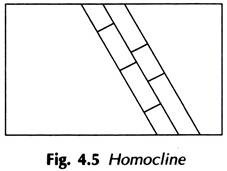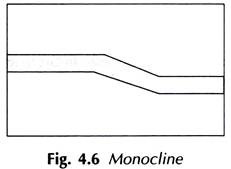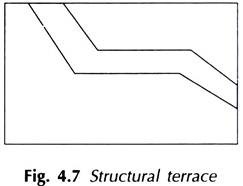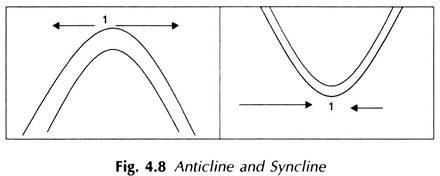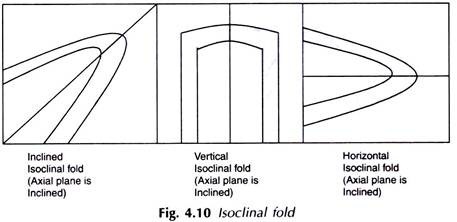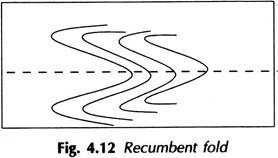ADVERTISEMENTS:
After reading this article you will learn about:- 1. Definition of Fold 2. Parts of a Fold 3. Types 4. Recognition 5. Engineering Considerations.
Definition of Fold:
It is frequently seen that the strata forming the earth’s crust have been not only tilted out of the horizontal but also bent and buckled into folds. Such a fold may range from microscopic crinkle to great arches and troughs even up to 100 kms across. A complete fold is composed of arched portion or Anticline and a depressed trough or syncline.
Parts of a Fold:
In a series of folds it is evident like waves. They consist of alternate crests and troughs. The crest of the fold is termed as anticline while the trough is called synclines. An anticline and syncline constitute a fold.
Limbs or Flanks:
Limbs or a flank of the fold is sloping side from the crest to the trough.
Axial plane:
An imaginary plane bisecting the vertical angle between equal slopes on either sides of the crest line.
Axis of the fold:
ADVERTISEMENTS:
The line that divides the section of the fold.
Types of Folds:
(A) Based on the geometrical appearance in cross-section, the types of folds are described below from simple to complex.
1. Homocline:
ADVERTISEMENTS:
Beds dipping in one direction but at the same angle.
2. Monocline:
Infect beds, there are steep dip at one or two places. Such a bed where inclination is high at one or two places compared to the rest.
3. Structural Terrace:
A bed, which is inclined in one direction, may become more or less flat at one place.
4. Anticline and Syncline:
ADVERTISEMENTS:
Anticline is simple fold, which is convex upwards. In Greek it means opposite inclined. In this fold the limbs dip always from each other.
 Syncline is simple fold, which is concave upwards. In Greek it means together inclined. In this fold the limbs dip towards each other.
Syncline is simple fold, which is concave upwards. In Greek it means together inclined. In this fold the limbs dip towards each other.
Symmetrical Anticline:
The axial plane is vertical.
Asymmetrical Anticline:
The axial plane is inclined.
Symmetrical Syncline:
The axial plane is vertical.
Asymmetrical Syncline:
The axial plane is inclined
5. Overturned Fold:
In this fold the two limbs dip in the same direction but at different angles. The axial plane is inclined.
6. Isoclinal Fold:
In Greek Isoclinal fold means the two limbs dip in the same direction but at the same angle.
7. Chevron Fold:
Usually the crest and troughs of a fold are rounded, but sometimes the folds are characterised by sharp crests and troughs. Such folds where the crests and troughs are sharp and angular are called Chevron Folds.
8. Recumbent Fold:
A fold in which the axial plane is absolutely horizontal and the limbs are also more or less horizontal is called Recumbent Fold as in the accompanying Fig. 4.12.
9. Drag Fold:
These are minor or small folds formed when competent beds (weak beds) moves over the incompetent beds. The axial planes of these folds are inclined to the bedding planes. Drag folds are useful in the determination of top and bottom of the beds.
10. Anticlinorium and Synclinorium:
Anticlinorium and Synclinorium are called respectively to exceptionally large sized fold. Anticline and Syncline when it is composite fold. An Anticlinorium is a fan shaped structure and the trend if the fold is anticline character.
Synclinorium is an exceptionally large sized fold in which the trend of the fold is synclinal in character.
(B) Folding of Rocks with Depth:
With depth the physical conditions change. This normally affects the folding of rocks when they are traced downward.
The following are the important types of the folding based on their behaviour with depth:
1. Similar Folding:
In this folding the bedding planes are similar having the dame shape downwards or upwards so the beds near the crest are thicker and the beds at the limbs are thinner.
2. Parallel Folding:
In this type of folding the bedding plane remains parallel through but because of this anticlines, which are sharp, becomes rounded and more broad. Similar Synclines, which are broad and rounded, becomes sharper with depth.
3. Diaper Fold:
This type of folding is common on sedimentary beds where more mobile beds are found at the centre. There are anticlines where more mobile core has broken through the overlying brittle rocks. Such folds are common in Salt beds in France.
4. Disharmonic Folding:
In this type, folding is not uniform throughout the stratigraphic column. Folding changes upwards or downwards as shown in figure. At the top folding is in the form of a simple anticline and passes to an overturned fold and still at more depth folding disappears.
5. Suprataneous Folding:
When folding and sedimentation are contemporaneous suprataneous folding is formed. The beds near the crest are thinner because the beds were rising. The beds near the troughs are thicker because the basin was sinking during sedimentation.
6. Decollement Fold:
In this type of folding a sheet of sedimentary bed breaks loose from the underlying fold independently without affecting the lower beds.
Recognition of Folds in the Field:
In recognition of folds the following factors are important:
1. The repetition of outcrops of beds suggests the present fold.
2. If folding is open the reversal of dip direction is enough to identify folds (as in the figure above). In anticlines the oldest bed will occupy an axial position, and in synclines the youngest bed will occur there.
3. In plunging fold as a rule give rise to curved outcrops the apex of which is called a ‘closure’.
4. In case of overturned and isoclinal folds, where all the limbs dip in the same direction, detailed observations are necessary to identify synclines and anticlines. The features which aid in finding out the stratigraphic top of a bed and hence the synclines and anticlines are drag folds, rock cleavage, cross-bedding, symmetrical ripple marks and graded bedding.
Engineering Considerations of Folds:
1. For a major project like a dam, tunnel, railway station, etc., a site which is highly folded should be avoided because the engineer may have to face much troubles sooner or later as folds are easily fractured even due to a slight disturbance.
2. If the project is of a scattered nature like electric or telephonic poles the work can be carried out without much of a risk.
3. Folds are also important to a water supply engineer specially when he has to select a suitable site for digging wells for water supply purpose. It has been observed that if the excavation of a well is done through impervious strata it will not yield any amount of water. If another well is excavated through previous strata it will yield abundance of water.
4. Synclinal folded rocks may yield hard and tough quality stones; whereas anticlinal folded rocks will yield weaker stones.
5. The anticlinal folds provide good prospects for stored petroleum, and hence in oil exploration, folds must not be overlooked.

